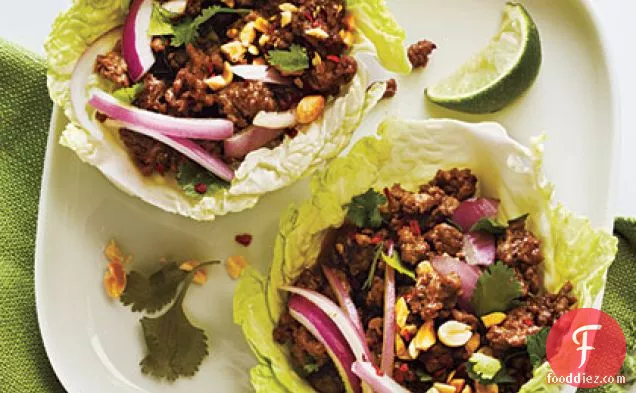Thai Beef Cabbage Cups

Thai Beef Cabbage Cups is a gluten free and dairy free recipe with 4 servings. One portion of this dish contains around 23g of protein, 22g of fat, and a total of 323 calories. This recipe covers 15% of your daily requirements of vitamins and minerals. It works well as a main course. This recipe is typical of Asian cuisine. From preparation to the plate, this recipe takes around 27 minutes. Head to the store and pick up onion, cilantro, fish sauce, and a few other things to make it today. To use up the sugar you could follow this main course with the Whole Wheat Refined Sugar Free Sugar Cookies as a dessert.
Instructions
Ingredients
0teaspoons![crushed red pepper]() crushed red pepper3teaspoons
crushed red pepper3teaspoons![dark sesame oil, divided]() dark sesame oil, divided2Tbsps
dark sesame oil, divided2Tbsps![finely chopped unsalted, dry-roasted peanuts]() finely chopped unsalted, dry-roasted peanuts2Tbsps
finely chopped unsalted, dry-roasted peanuts2Tbsps![fish sauce]() fish sauce118milliliters
fish sauce118milliliters![chopped fresh cilantro]() chopped fresh cilantro2teaspoons
chopped fresh cilantro2teaspoons![minced peeled fresh ginger]() minced peeled fresh ginger3
minced peeled fresh ginger3![garlic cloves, minced]() garlic cloves, minced454grams
garlic cloves, minced454grams![ground sirloin]() ground sirloin2Tbsps
ground sirloin2Tbsps![fresh lime juice]() fresh lime juice8larges
fresh lime juice8larges![green cabbage leaves]() green cabbage leaves118milliliters
green cabbage leaves118milliliters![vertically sliced red onion]() vertically sliced red onion1Tbsp
vertically sliced red onion1Tbsp![sugar]() sugar1Tbsp
sugar1Tbsp![water]() water
water
 crushed red pepper3teaspoons
crushed red pepper3teaspoons dark sesame oil, divided2Tbsps
dark sesame oil, divided2Tbsps finely chopped unsalted, dry-roasted peanuts2Tbsps
finely chopped unsalted, dry-roasted peanuts2Tbsps fish sauce118milliliters
fish sauce118milliliters chopped fresh cilantro2teaspoons
chopped fresh cilantro2teaspoons minced peeled fresh ginger3
minced peeled fresh ginger3 garlic cloves, minced454grams
garlic cloves, minced454grams ground sirloin2Tbsps
ground sirloin2Tbsps fresh lime juice8larges
fresh lime juice8larges green cabbage leaves118milliliters
green cabbage leaves118milliliters vertically sliced red onion1Tbsp
vertically sliced red onion1Tbsp sugar1Tbsp
sugar1Tbsp water
waterRecommended wine: Chenin Blanc, Gewurztraminer, Riesling
Chenin Blanc, Gewurztraminer, and Riesling are my top picks for Asian. The best wine for Asian food depends on the cuisine and dish - of course - but these acidic whites pair with a number of traditional meals, spicy or not. One wine you could try is Lang & Reed Napa Valley Chenin Blanc. It has 4.5 out of 5 stars and a bottle costs about 30 dollars.

Lang & Reed Napa Valley Chenin Blanc
The Lang & Reed 2015 Chenin Blanc – Napa Valley has peach and tropical fruit that are immediately on the nose, with the necessary hint of honeycomb (the traditional varietal character), and a lesser expression of apple and citrus. On the palate, the aromas are mirrored and given an even stronger presence with yellow apple exotic citrus notes, which give it an accurate tartness. The texture is tender, and the flavors broaden with a touch of saline minerality, which leads into bright crisp acidity, adding to the wine’s refreshing character. It will blossom and gain in complexity with additional bottle time.DifficultyMedium
Ready In27 m.
Servings4
Health Score12
Magazine

Your Inner Chef with Taylor Swift's Top 3 Recipes from Her Beloved NYC Hangout

20 Mouthwatering Recipes You Need to Try Today!

Master the Art of Making Perfect Pancakes with This Foolproof Recipe

The Science Behind Red Wine: Its Surprising Health Benefits and Potential Risks

12 Wine Cocktails for a Sophisticated Twist

Sip, Swirl, and Celebrate: Toasting to National Wine Day on May 25th

National Drink Wine Day on February 18

Celebrating Souffle Day with Delectable Delights

Indulge in the Delightful Flavor of Oyster Soup on Its Special Day!

Celebrating World Nutella Day

Ten Healthy and Budget-Friendly Foods

Foods You Should Freeze to Save Money

Creative Ways to Turn Leftovers into Breakfast

Rice or Quinoa – Which is the Healthier Choice?

11 Cost-Effective and Healthy Meals

15 Healthy Recipes that Use Leftover Chicken Breast

5 Minute Recipes – When Time is of the Essence

Chicken Recipes Collection – Ideas for Every Taste

Quick Recipes Collection – Tasty Food in a Hurry

Top 10 Christmas Cookies Recipes

Your Inner Chef with Taylor Swift's Top 3 Recipes from Her Beloved NYC Hangout

20 Mouthwatering Recipes You Need to Try Today!

Sip, Swirl, and Celebrate: Toasting to National Wine Day on May 25th

National Drink Wine Day on February 18

Indulge in the Delightful Flavor of Oyster Soup on Its Special Day!

These Super Recipes for Your Football Party!

The Secrets Behind 3 Classic Comfort Food Recipes

Recipes to Spice Up Your February Menu

Top 20+ Must-Try Recipes Dominating February 2024


